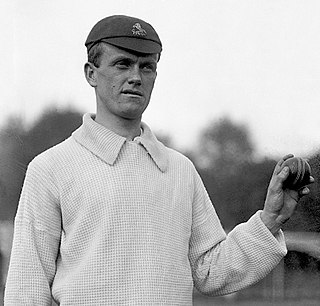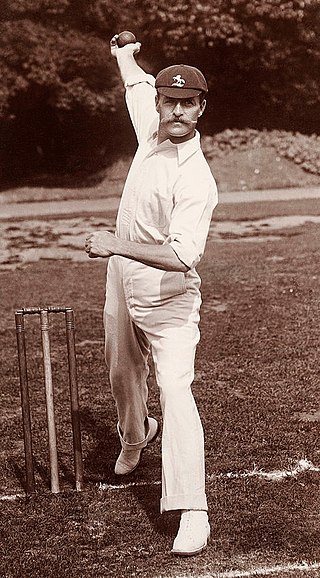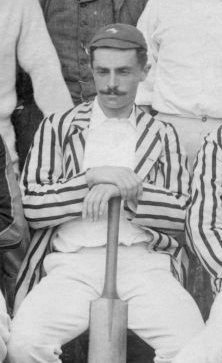
Kent County Cricket Club is one of the eighteen first-class county clubs within the domestic cricket structure of England and Wales. It represents the historic county of Kent. A club representing the county was first founded in 1842 but Kent teams have played top-class cricket since the early 18th century, and the club has always held first-class status. The current Kent County Cricket Club was formed on 6 December 1870 following the merger of two representative teams. Kent have competed in the County Championship since the official start of the competition in 1890 and have played in every top-level domestic cricket competition in England. The club's limited overs team is called the Kent Spitfires after the Supermarine Spitfire.

The St Lawrence Ground is a cricket ground in Canterbury, Kent. It is the home ground of Kent County Cricket Club and since 2013 has been known as The Spitfire Ground, St Lawrence, due to commercial sponsorship. It is one of the oldest grounds on which first-class cricket is played, having been in use since 1847, and is the venue for Canterbury Cricket Week, the oldest cricket festival in the world. It is one of the two grounds used regularly for first-class cricket that have had a tree, the St Lawrence Lime, within the boundary.

Colin Blythe, also known as Charlie Blythe, was an English professional cricketer who played Test cricket for the England cricket team during the early part of the 20th century. Blythe was a Wisden Cricketer of the Year in 1904 and took more than 2,500 first-class wickets over the course of his career, one of only 13 men to have done so.

Frank Edward Woolley was an English professional cricketer who played for Kent County Cricket Club between 1906 and 1938 and for the England cricket team. A genuine all-rounder, Woolley was a left-handed batsman and a left-arm bowler. He was an outstanding fielder close to the wicket and is the only non wicket-keeper to have held over 1,000 catches in a first-class career, whilst his total number of runs scored is the second highest of all time and his total number of wickets taken the 27th highest.

Frederick Martin, also known as Fred Martin and Nutty Martin, was an English professional cricketer who bowled left-arm medium-pace spin. Martin played first-class cricket between 1885 and 1892, primarily for Kent County Cricket Club, and appeared twice in Test matches for the England cricket team. He was considered one of the best left-arm spin bowlers in the country between 1889 and 1891.

Alec Hearne was a member of the famous cricketing Hearne family. He played as a professional for Kent County Cricket Club between 1884 and 1906 and made one Test match appearance for England. He was an all-rounder who was named as one of Wisden's five Cricketers of the Year in 1894. His father, George played cricket for Middlesex during the 1860s and brothers George and Frank also played Test cricket, as did his cousin, John Thomas Hearne.

The Crabble Athletic Ground, also known as simply Crabble, or The Crabble is a football stadium located in the northern Dover suburb of River, Kent. It was the home of the various incarnations of Dover F.C. from 1931 until the club folded in 1983. Since then it has been the home of Dover Athletic F.C., and it was also the temporary home of Margate F.C. between 2002 and 2004, when the club's Hartsdown Park stadium was being redeveloped. The stadium has two seated stands and two covered terraces and holds a total of 5,745 fans, although in the past, crowds larger than that figure could be accommodated. It also has a clubhouse, which the club completely redeveloped in 2008.

Rectory Field is a sports ground in Blackheath in the Royal Borough of Greenwich in south-east London. It was developed in the 1880s by Blackheath Cricket, Football and Lawn Tennis Company and became the home ground of rugby union team Blackheath F.C. between 1883 and 2016. The ground has hosted international rugby matches and at one time, along with the Richmond Athletic Ground, it was the unofficial home of the England national rugby union team before the development of Twickenham Stadium. The ground was also used for first-class and List A cricket by Kent County Cricket Club between 1887 and 1972. The field is named after the Charlton Rectory that once stood at the site. It is used today by Blackheath Sports Club for cricket, rugby, tennis and squash.
B. M. Close's Ground was a cricket ground at Southborough in the English county of Kent. The ground was established in 1859 by Robert Winnifrith on land owned by George Newnham of Horsemunden Farm and was described in 1862 as "one of the best cricket grounds in Kent". The first recorded match on the ground was in 1859, when a Tunbridge Wells side played a New All-England Eleven.
Frederick Hammett Knott, known as Freddie Knott, was an English amateur cricketer. Knott played for Oxford University Cricket Club and Kent County Cricket Club in the years before the First World War. He played occasionally after the war, including once for Sussex in 1926.
William John Fairservice was an English professional cricketer who played first-class cricket for Kent County Cricket Club between 1902 and 1921. He was a right-arm medium-pace off-break bowler who batted in the lower order and played over 300 first-class matches in his career. After his cricketing career he coached cricket and was a scorer. His son, Colin Fairservice, played for Kent and Middlesex from 1929 to 1936.
Kent County Cricket Club's 1906 season was the seventeenth season in which the county competed in the County Championship and saw the side win their first Championship title. Kent played 25 first-class cricket matches during the season, losing only four matches overall, and only two matches in the 1906 County Championship. They finished equal on points with Yorkshire and Surrey but won the title on the percentage of finished matches won.
Kent County Cricket Club's 1909 season was the twentieth season in which the county club competed in the County Championship. Kent played 30 first-class cricket matches during the season, losing only two matches overall, and won their second championship title. They finished clearly ahead of second place Lancashire in the 1909 County Championship with the previous year's winners, Yorkshire, in third place.
David William Jennings was an English cricketer who played first-class cricket for Kent County Cricket Club in the years before the First World War. Primarily a batsman, Jennings played in the Kent sides which won the County Championship in 1909, 1910 and 1913.
Kent County Cricket Club's 1910 season was the 21st season in which the County competed in the County Championship. Kent played 29 first-class cricket matches during the season, losing only five matches overall, and won their third Championship title. They finished well ahead of second place Surrey in the 1910 County Championship.
William Allan Powell was an English amateur cricketer who played first-class cricket for Kent County Cricket Club during the Golden Age of cricket before the First World War. He was born in 1885 Blundellsands in Lancashire and educated at Cranleigh School. He died in Earl's Court in London on New Years Day 1954, aged 68.

Leslie Wilson was an English stockbroker and cricketer who played for Kent County Cricket Club between 1883 and 1897. Wilson played in over 100 first-class matches for Kent and scored over 3,000 runs for the county.
Henry Croxford was an English professional cricketer who played for Kent County Cricket Club during the 19th century. He was born at Hadlow in Kent in 1845, the son of William and Sophia Croxford. His father was a boot maker.









